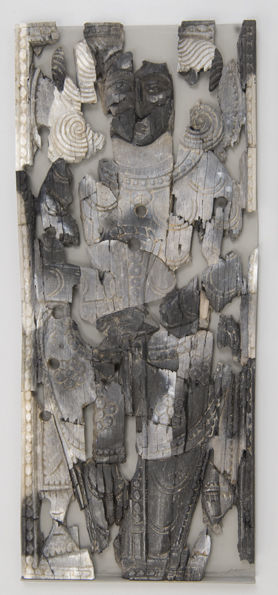
Furniture Veneer Panel, first half of the 8th century. Probably made east of the Euphrates River, excavated at al-Humayma, Jordan. Single sheet of elephant ivory. Department of Antiquities, Amman
In the interview with Pete Dandridge, we learned about the challenges involved in treating and displaying the delicate ivory panels from al-Humayma. The thoughtful and considerate conservation work on these pieces allows us to see amazing remnants of a large Abbasid residence located in the Hisma desert of southern Jordan. They also represent—through the figures' wardrobes and poses—a point of contact between multiple cultures.
Christian populations, as Rebecca Foote discusses in her essay for the exhibition catalogue, built at least five churches in al-Humayma during the fifth and sixth centuries, and maintained contact with the wider Byzantine empire as well as with the Sasanians. In the late seventh or early eighth century, the Abbasids, a Muslim family from Mecca, purchased the territory and built a large residence there, along the route connecting Damascus with Mecca and Medina.
The ivory panels on view in the exhibition, one of which is shown above, were most likely created as decoration for wooden furniture, and the imagery they contain is secular, showing male figures wearing Persianate tunics. The daisy motifs decorating the tunics of the men on two of the panels are reminiscent of the heart-shaped decorations in the late sixth- to early seventh-century wall hanging from the Benaki Museum. The figures' fully frontal poses were common in representations of political figures. See, for example, the illumination showing Charles the Bald in the ninth-century Carolingian manuscript known as the Codex Aureus of St. Emmeram—like these figures, he is shown with knees angled outward, and holding a jeweled sword. This pose also appears in earlier images, such as that of Mordecai at Dura Europos, the third-century site in modern-day Syria. The same seated position appears in Sasanian art, such as the fourth-century relief of Shapur II in Bishapur, Iran. There are ways in which this pose also reflects Early Christian iconography, especially depictions of the Virgin Mary and Christ.
The Grado Ivories, as Foote points out, also provide an interesting comparison to these furniture panels. Although clearly Christian, the Grado Ivories are similar to the al-Humayma ivories in size, shape, and decorative function. While she reminds us that the al-Humayma ivories were political and not religious, the persistence of certain features from earlier artistic traditions is striking. In this last weekend of the exhibition, take an extra moment to look closely at these ivories. Patient attention to the details—the penetrating faces, the delicate and expressive placement of the hands, the veritable bouffant hairstyle with looping, generous curls just above the shoulders—is well worth the time.
Sources
Azarpay, Guitty. "Bishapur VI: An Artistic Record of an Armeno-Persian Alliance in the Fourth Century." Artibus Asiae, vol. 42 (1981–82), 171–189.
Foote, Rebecca M. "An Abbasid Residence at al-Humayma," In Byzantium and Islam: Age of Transition. Ed. Helen C. Evans and Brandie Ratliff. New York: Metropolitan Museum of Art, 2012, 221
Foote, Rebecca M. "Furniture Veneer Panels," in Byzantium and Islam: Age of Transition. Helen C. Evans and Brandie Ratliff. New York: Metropolitan Museum of Art, 2012, 221-222.
Harper, P.O. "Thrones and Enthronement Scenes in Sasanian Art." Iran 17 (1979), 49–64.
Levit-Tawil, Dalia. "Enthroned King Ahasuerus at Dura," The American Schools of Oriental Research (Spring 1983): 57–78.